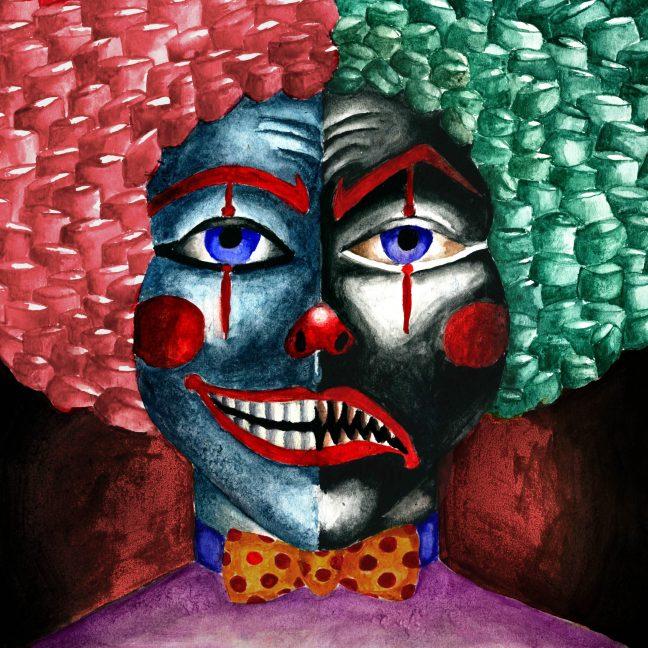A large red nose, floppy-looking feet and a face covered in white cream makeup are the features that both entertain children at birthday parties and devise the plots of horror movies.
Clowns, originally crowd-pleasing entertainers, have increasingly incited panic in people who catch a glimpse of a rubber clown mask.
Emerging from forests and chasing college students around campuses, clowns have startled and concerned people across the nation.
This phenomenon has hit close to home. According to USA Today, one clown called “Gags” was spotted in Green Bay walking around at night carrying black balloons.
Reports continue to state the untruth that the creepy clown pandemic began in SC on Aug 21. WI's Gags was first seen on Aug 1, journalists. pic.twitter.com/VsL9LTd6q9
— Evan Harrison Cass (@evancass) October 16, 2016
These clowns might not be breaking the law, but they still have inspired mass hysteria among college students at Pennsylvania State University and fear among residents in Wisconsin.
When rumors of a clown sighting at Penn State spread through social media at the beginning of October, hundreds of students on the campus took to the streets in search of the clown, according to Time.
HALF THE CAMPUS IS ON LOCKDOWN AND THE OTHER HALF IS A MOB RUNNING AROUND CLOWN HUNTING @PENNSTATE WHAT IS GOING ON
— Connor (@Connor4jan) October 4, 2016
https://twitter.com/calebmadison_/status/788508593817579520
Though it may seem unlikely that a single clown could cause a mass mob of students to crowd the streets, it is the clown’s common association with its distorted, horrific depiction in movies that has the power to incite fear, University of Wisconsin communication arts professor Joanne Cantor said.
Coulrophobia: the fear of clowns
With rosy cheeks and big red noses, clowns have traditionally been intended for entertainment. Today, however, they are more likely to be a source of fear.
For some people, a clown’s overly friendly and harmless nature can actually emerge as threatening. This misperception is an anomaly in the human psyche, Cantor said.
Clowns’ friendly faces are the epitome of good gone bad. Cantor said that although clowns act relatively silly, their image may appear scary to some, especially children.
“What frightens you is different at different ages,” Cantor said. “Particularly for young kids, something that looks sort of like a normal thing but is distorted in some way is really scary.”
Behind the curtain of Madison’s concert venues, the undead put on their own performances
Cantor said many people she interviewed for her research on the impact media has on fear have had bad experiences with clowns during their childhood. Those same people later reported they hate clowns as adults.
Deanna Loewenhagen, otherwise known by her professional clowning name of “Apple Annie,” has been an entertainer for 40 years. She said clown phobia has forced her and fellow professional entertainers to learn how to read body language and determine if their presence is unwelcome. If a person appears afraid, Loewenhagen said she is careful not to overwhelm them.
Loewenhagen said when nonprofessionals dress like clowns, they often fail at appearing friendly because they don’t know how to properly wear a clown costume. Instead, she said, they look ugly and ultimately scary.
“We appear during the day, we don’t go out at night, we don’t jump out in front of people,” Loewenhagen said. “We don’t want to scare children.”
Loewenhagen said clown hysteria is resurrected every Halloween, but this year it is even more prevalent because of the various sightings of creepy clowns across the nation.
These sightings have made it increasingly difficult for professional clowns like Loewenhagen to come across as a harmless source of entertainment.
The fear of clowns and overall hysteria is saddening, Loewenhagen said, because it could lead to a decrease in the number of people who want to pursue clowning as a career and art form.
The horror attraction
The public’s increasing perception of clowns as scary figures can be connected to their prevalent portrayal as serial killers and stalkers in horror movies.
“Mass media in general and literature too, visual images, are so important. They really bring the clown power, bring it to life and make it so memorable.”
A fear of clowns is often caused by popular horror movies released during a viewer’s formative years, Cantor said.
Loewenhagen said the release of horror films like “Poltergeist” from the 1980s and Stephen King’s “It” from the 1990s, where clowns are depicted as villains, was the turning point in which the public’s fear of clowns turned into hysteria.

Prior to those movies, she said she rarely encountered someone who feared clowns and that some people even collected clown memorabilia. Clowns like Bozo and Ronald McDonald used to be on cookie jars and were represented positively in the media.
The genre of horror films has the power to manipulate people’s fears, Cantor said. While audiences don’t necessarily like violence, they find themselves innately attracted to it because it arouses their interest.
Visual images in horror movies can influence what people perceive to be scary. After watching the movie “It,” many people began to associate all clowns with their perception of the killer clown character, Cantor said.
“Mass media in general and literature too, visual images, are so important,” Cantor said. “They really bring the clown power, bring it to life and make it so memorable.”
Viewers escape their own reality when watching a horror movie and are confronted with an alternate reality with unfamiliar problems, Cantor said. People are attracted to the idea of forgetting about their own problems and distracting themselves with someone else’s. This, in turn, relieves people because they can watch other people experience a “living hell,” she said.
“By incorporating violence, horror movies have been able to manipulate people’s fears into an appealing portrayal, even if people don’t necessarily enjoy the feelings horror movies induce,” Cantor said.
Horror films’ commercial success has increased as modern technology has become more advanced and the movies have become more realistic. Cantor said incomplete plot lines make horror movies easy to produce. In order to gain an audience’s attention, horror movies can simply depict a character having their throat slashed without ever having to present a solid plot.
While these movies may be attention grabbing, the graphic visual images may negatively influence viewers, particularly those with mental health problems. The powerful images in horror movies make those with mental health problems more vulnerable to reenact what they’ve watched, Cantor said.
Overcoming fear
Though people continue to see clowns as scary figures, professional clowns like Loewenhagen work to help people overcome the fear and negative stereotypes surrounding clowns.
Loewenhagen said professional clowns aren’t just sitting back and taking a hit from creepy clowns. They are taking action to prove that most clowns are friendly.
“[Creepy clowns] think it’s funny because people are now afraid and there is an association with killer clowns and robberies and murders and doing bad things to children — everything opposite that a clown would do.”
Clowns can combat negativity toward their image by joining a larger clown organization, such as the World Clown Association. Groups like this have strict rules for clowns to ensure people adhere to standards for good, clean clowning, Loewenhagen said.
Additionally, clowns can take preemptive measures by taking clown classes and understanding how to be courteous to people who have a fear of clowns, she said.
“I watch myself, [when] I go [out] in my clown costume,” Loewenhagen said. “If I have to go to the bathroom, I’ll [walk in] and say, ‘Clown is in the building, I’m a friendly clown,’ so that they know.”
Though people’s fears of clowns have been rationalized through their portrayal in the media, Loewenhagen said she still believes people should not feel this way.
Professional clowns know what they are doing and how to address people’s fear properly because they don’t want to frighten someone in the first place, Loewenhagen said.
“[Creepy clowns] think it’s funny because people are now afraid and there is an association with killer clowns and robberies and murders and doing bad things to children — everything opposite that a clown would do,” Loewenhagen said.




















